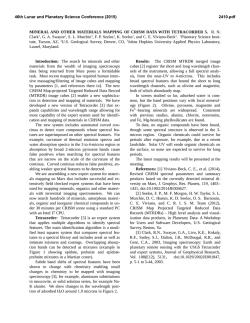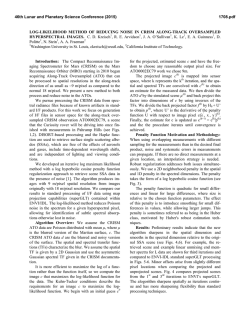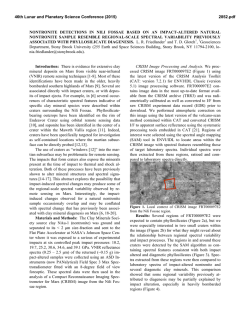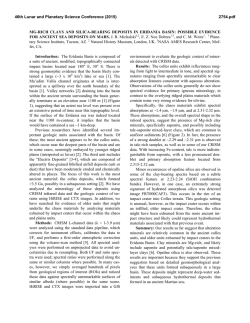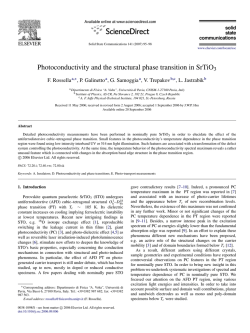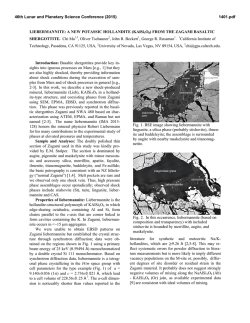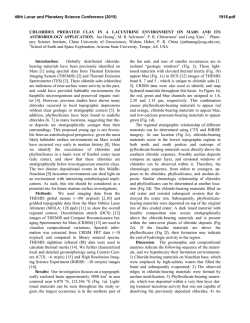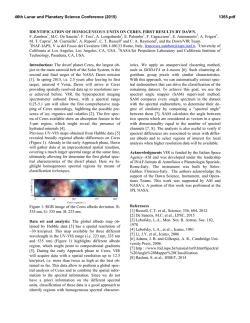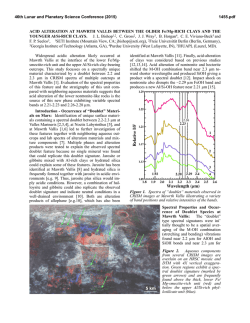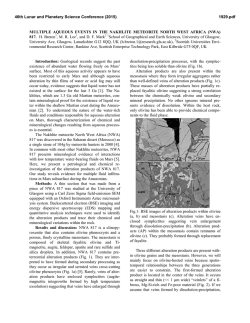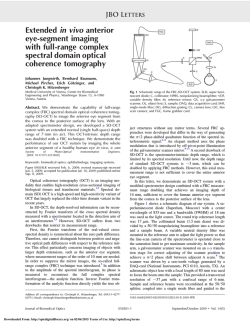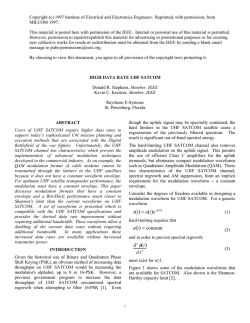
Diverse Morphology and Mineralogy of Aqueous Outcrops at Libya
46th Lunar and Planetary Science Conference (2015) 1738.pdf DIVERSE MORPHOLOGY AND MINERALOGY OF AQUEOUS OUTCROPS AT LIBYA MONTES, MARS D. Tirsch1, J. L. Bishop1,2, J. Voigt1,3, L. L. Tornabene4, G. Erkeling5, H. Hiesinger5 and R. Jaumann1,3 1 Institute of Planetary Research, German Aerospace Center (DLR), Berlin, Germany, [email protected]. 2Carl Sagan Center, SETI Institute, Mountain View, CA, USA.3Institute of Geological Sciences, Freie Universität Berlin, Berlin, Germany. 4Dept. of Earth Sciences, Centre for Planetary Science and Exploration, University of Western Ontario, London, Canada. 5Institut für Planetologie, Westfälische Wilhelms-Universität Münster, Germany. Introduction: The Libya Montes are part of the southern rim-complex of the Isidis impact basin on Mars. The region is characterized by pre-Noachian and Noachian aged highland rocks alternating with multiple sedimentary units of Noachian to Amazonian age, some of them heavily dissected by dense valley networks [1 - 7]. The region experienced a complex history of impact, volcanic, tectonic, fluvial and aeolian modification processes resulting in the geology observed today. Ancient aqueous outcrops have been identified by coordinated spectral and geological analyses at various locations in the region [7]. The study site is centered at 85.4° E and 3.5° S and comprises most geological units and morphological expressions of surface-forming processes that are typical for the wider region. Our results reveal clues about the geological history of the study site in context with regionally acting modification processes. Methods: We performed a photogeological mapping, as well as morphological and spectral analyses on a variety of datasets. HRSC topography (50 m/px), HiRISE and CTX imagery (25 cm/px and 6 m/px), and CRISM spectral data (18/33.8 m/px) have been used to reveal the geological setting of the region. Specific geologic units indicated by CRISM mineral maps derived from spectral parameter products (R: BD2300, G: OLV, B: LCP), have been evaluated mineralogically using the CRISM analysis tool (CAT) in ENVI and comparison with lab spectra of known composition. Spectral ratios were used to emphasize absorption features of surface outcrops. Geological mapping was performed using the mapping tools of Figure 1: Geological map of the study site at Libya Montes as inferred from spectral and image data. Mapping basis: CRISM mineral maps, CTX imagery and HRSC topography. 46th Lunar and Planetary Science Conference (2015) ArcGIS and a mapping scale of 1:40.000. Geological units are deduced from spectral and morphological interpretation of the spectral and image data. Hence, morphological units are associated with their major mineralogical compounds. Areas lacking CRISM coverage have been interpreted solely on the basis of their morphological expression. Their mineralogy was assigned by careful extrapolation from nearby units of similar morphology/texture and known mineralogical information from CRISM. Results and Discussion: The geological history of the region as revealed by the analysis comprises an emplacement of olivine-rich lava onto ancient basaltic bedrock, which was later covered by pyroxene-rich caprock (Fig. 1). This latter extended top unit might either represent lava layers, presumably originating from the Syrtis Major province [1], or indurated mud flows emplaced by mud volcanism [8]. Smaller outcrops of phyllosilicate-rich materials are located where subsurface facies are exposed to the surfaces, e.g., at the central peak of Hashir crater (Fig. 2a), at areas of high erosion, or within the walls of Duvolo crater (Fig. 1). These outcrops are enriched in Fe-/Mgphyllosilicates and have a hummocky texture (Fig. 2 a,b,e). We suggest that these minerals result from the partial alteration of the ancient bedrock through hydrothermal alteration (presumably triggered by the Isidis impact) and/or later by hydrous alteration caused by fluvial activity. Aeolian and fluvial activity led to extensive erosion of the mantling geological units, likewise supporting the excavation of the clays. Fluviolacustrine processes also led to the deposition of deltaic deposits and an alluvial fan (Fig. 1). Layered Al-rich smectites, beidellite in this case, have been detected in the delta body (Fig. 2d, cf. [9]). In the western part of the study region, massif units enriched in Al-smectites have also been detected at the flanks of the ancient bedrock (Fig. 2c), indicating that they might be the result of aqueous alteration of the pyroxene-bearing bedrock and/or caprock, occurring a long time after the formation of the Fe/Mg-clays. We also observe carbonate-bearing outcrops in two spots of the study region: In the western part, these carbonates are intermixed with Fe-/Mg-smectites (Fig. 2e) and in the eastern part they are exposed at some small outcrops along eroded highland flanks (Fig. 2f). These detections suggest aqueous alteration that is associated with Mg-/Fe-rich fluids under a CO2-rich atmosphere [10]. The variability in phyllosilicates and the presence of carbonates imply a changing alteration environment. Acknowledgements: We thank the MRO and Mars Express teams for successful planning and acquisition of the data and NASA’s PGG program for support of the project. 1738.pdf Figure 2: Morphology of different phyllosilicate-rich outcrops at Libya Montes reflecting a heterogeneous formation history (CTX close-ups). References: [1] Tornabene, L. L. et al. (2008) JGR 113, doi: 10.1029/2007JE002988. [2] Scott D. H. & Tanaka K. L. (1986) USGS map# I-1802-A. [3] Crumpler, L. S. & Tanaka, K. L. (2003) JGR, 108, doi: 10.1029/2002JE002040. [4] Jaumann, R. et al. (2010) EPSL 294, 272-290. [5] Erkeling et al. (2010) EPSL 294, 291-305. [6] Tanaka K. L. et al. (2014) USGS SIM 3292. [7] Bishop, J. L. et al. (2013) JGR, 118, 487-513. [8] Ivanov, M. A. et al. (2014) Icarus 228, 121-140. [9] Erkeling et al. (2012) Icarus 219, 393413. [10] Niles, P. B. et al. (2013) Space Sci. Rev., 174, 301-328.
© Copyright 2025
